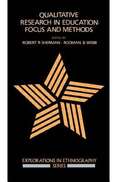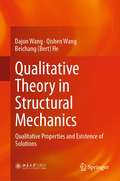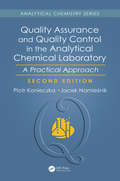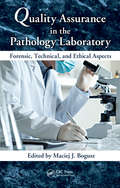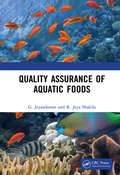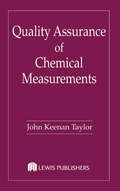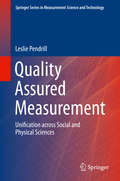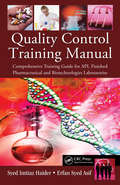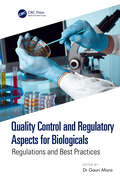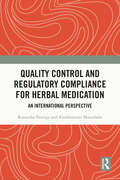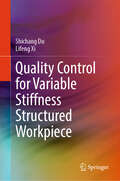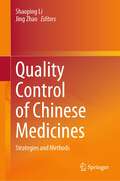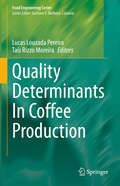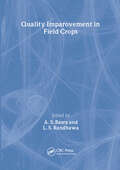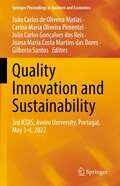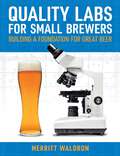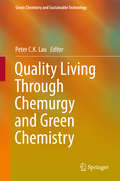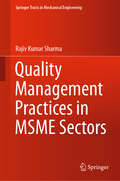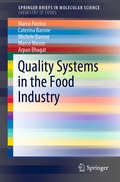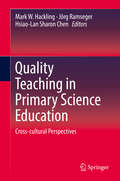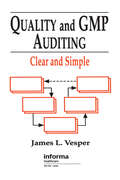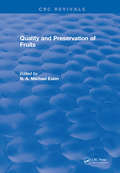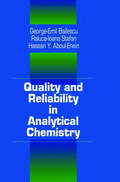- Table View
- List View
Qualitative Research Methods for the Social Sciences, Eighth Edition
by Bruce L. Berg Howard LuneThis text shows novice researchers how to design, collect, and analyze qualitative data and then present their results to the scientific community. The book stresses the importance of ethics in research and taking the time to properly design and think through any research endeavor.
Qualitative Research in Education: Focus and Methods
by Robert R. Sherman Rodman B. WebbQualitative research has had a thorough-going and controversial impact on the field of educational research, both generally and specifically. Qualitative approaches have colonised, or have been colonised by, almost all theoretical varieties of educational research. Such variation and varigation is evidenced and documented in this volume. But this kind of enthusiastic development and take up has its dangers and problems. The potential of qualitative methods can be blunted or distorted by the cavalier abandonment of first principles or disregard for techniques or rigour. In this collection of papers a careful and systematic review is provided of the current possibilities and necessities of good qualitative research.
Qualitative Theory in Structural Mechanics: Qualitative Properties and Existence of Solutions
by Dajun Wang Qishen Wang Beichang (Bert) HeThis book focuses on the qualitative theory in structural mechanics, an area that remains underdeveloped. The qualitative theory mainly deals with the static deformation and vibrational modes of linear elastic structures, and cover subjects such as qualitative properties and the existence of solutions.Qualitative properties belong to one type of structure, are at the system level and of clear regularity, and often result from analytical derivation and logical reasoning. As for the existence of solutions, it addresses a fundamental issue in structural mechanics, and has far-reaching implications for engineering applications.A better understanding of qualitative properties can assist in both numerical computation and experimental studies. It also promotes the development of better dynamic designs for structures. At the same time, a sound grasp of the existence of solutions and related subjects can aid in quantitative analysis, and help researchers establish the theoretical background essential to their work. This book is among the few that is dedicated exclusively to the qualitative theory in structural mechanics and systematically introduces the important and challenging area to a wide audience, including graduate students in engineering.
Quality Assurance and Quality Control in the Analytical Chemical Laboratory: A Practical Approach, Second Edition (Analytical Chemistry)
by Piotr Konieczka Jacek NamiesnikThe second edition defines the tools used in QA/QC, especially the application of statistical tools during analytical data treatment. Clearly written and logically organized, it takes a generic approach applicable to any field of analysis. The authors begin with the theory behind quality control systems, then detail validation parameter measurements, the use of statistical tests, counting the margin of error, uncertainty estimation, traceability, reference materials, proficiency tests, and method validation. New chapters cover internal quality control and equivalence method, changes in the regulatory environment are reflected throughout, and many new examples have been added to the second edition.
Quality Assurance in the Pathology Laboratory: Forensic, Technical, and Ethical Aspects
by Maciej J. BoguszQuality refers to the amount of the unpriced attributes contained in each unit of the priced attribute.Leffler, 1982Quality is neither mind nor matter, but a third entity independent of the two, even though Quality cannot be defined, you know what it is.Pirsig, 2000The continuous formulation of good practices and procedures across fields reflects t
Quality Assurance of Aquatic Foods
by G. Jeyasekaran R. Jeya ShakilaThis book deals with the quality and safety of aquatic food. It focuses clearly on biological and chemical hazards, antibiotic and pesticide residues, and heavy metal contaminants associated with aquatic food. The quality problems in various aquatic food products and their methods of assessment are exhaustively dealt in this book. Besides, food quality management systems like HACCP, SSOP, SCP, GHP, GMP have also been explained for easy adoption. The International and National Standards prescribed by FSSAI, EIC, BIS, Codex, USFDA, ISO and EU for aquatic food products are explicitly given. It is also useful to the personnel of aquatic food industries to improve their working knowledge on maintaining the quality and safety aquatic foods. Note: T& F does not sell or distribute the Hardback in India, Pakistan, Nepal, Bhutan, Bangladesh and Sri Lanka.
Quality Assurance of Chemical Measurements
by John K. TaylorThis definitive new book should appeal to everyone who produces, uses, or evaluates scientific data. Ensures accuracy and reliability. Dr. Taylor's book provides guidance for the development and implementation of a credible quality assurance program, plus it also provides chemists and clinical chemists, medical and chemical researchers, and all scientists and managers the ideal means to ensure accurate and reliable work. Chapters are presented in a logical progression, starting with the concept of quality assurance, principles of good measurement, principles of quality assurance, and evaluation of measurement quality. Each chapter has a degree of independence so that it may be consulted separately from the others.
Quality Assured Measurement: Unification across Social and Physical Sciences (Springer Series in Measurement Science and Technology)
by Leslie PendrillThis book presents a general and comprehensive framework for the assurance of quality in measurements. Written by a foremost expert in the field, the text reflects an on-going international effort to extend traditional quality assured measurement, rooted in fundamental physics and the SI, to include non-physical areas such as person-centred care and the social sciences more generally. Chapter by chapter, the book follows the measurement quality assurance loop, based on Deming’s work. The author enhances this quality assurance cycle with insights from recent research, including work on the politics and philosophy of metrology, the new SI, quantitative and qualitative scales and entropy, decision risks and uncertainty when addressing human challenges, Man as a Measurement Instrument, and Psychometry and Person-centred care. Quality Assured Measurement: Unification across Social and Physical Sciences provides students and researchers in physics, chemistry, engineering, medicine and the social sciences with practical guidance on designing, implementing and applying a quality-assured measurement while engaging readers in the most novel and expansive areas of contemporary measurement research.
Quality Control Training Manual: Comprehensive Training Guide for API, Finished Pharmaceutical and Biotechnologies Laboratories
by Syed Imtiaz Haider Syed Erfan AsifWritten to help companies comply with GMP, GLP, and validation requirements imposed by the FDA and regulatory bodies worldwide, Quality Control Training Manual: Comprehensive Training Guide for API, Finished Pharmaceutical and Biotechnologies Laboratories presents cost-effective training courses that cover how to apply advances in the life sciences to produce commercially viable biotech products and services in terms of quality, safety, and efficacy. This book and its accompanying downloadable resources comprise detailed text, summaries, test papers, and answers to test papers, providing an administrative solution for management. Provides the FDA, Health Canada, WHO, and EMEA guidelines directly applicable to pharmaceutical laboratory-related issues Offers generic formats and styles that can be customized to any organization and help management build quality into routine operations to comply with regulatory requirements Contains ready-to-use training courses that supply a good source of training material for experienced and inexperienced practitioners in the biotechnology/biopharmaceutical industries Includes downloadable resources with downloadable training courses that can be adopted and directly customized to a particular organization Supplies ready-to-use test papers that allow end users to record all raw data up to the issuance of the attached certificate The biotechnology/bioscience industries are regulated worldwide to be in compliance with cGMP and GLP principles, with particular focus on safety issues. Each company must create a definite training matrix of its employees. The training procedures in this book enable end users to understand the principles and elements of manufacturing techniques and provide documentation language ranging from the generic to the specific. The training courses on the downloadable resources supply valuable tools for developing training matrices to achieve FDA, Health Canada, EMEA, MHRA UK, WHO, and GLP compliance.
Quality Control and Regulatory Aspects for Biologicals: Regulations and Best Practices
by Gauri MisraThis book serves as a comprehensive guide on quality control and regulatory aspects for biological products. It covers a wide range of topics, including regulatory requirements, quality control strategies, analytical methods, and risk management. It delves into the advantages and limitations of in vivo tests and discusses alternative methods that can be employed. The book explores the use of animal-based testing methods in quality control and examines viable alternatives.Key Features: Reviews various scientific and regulatory aspects involved in the quality control of biologicals Provides an overview of the roles of various national and international regulatory bodies and accreditation agencies Presents advanced analytical methods, innovative technologies, and the integration of molecular diagnostics in quality control processes Explores the use of animal-based testing methods in quality control, as well as their alternatives Discusses guidelines and methodologies involved in the development of biological products Overall, this book is an important reference source for various professionals in the pharmaceutical industry, including researchers, scientists, quality control personnel, and regulatory affairs professionals.
Quality Control and Regulatory Compliance for Herbal Medication: An International Perspective
by Krishnaveni Manubolu Raveesha PeerigaThis comprehensive book provides a detailed framework for the evaluation and standardization of herbal products, promoting the safe and effective use of herbal medicines through rigorous testing and compliance with global regulatory requirements.It begins with an overview of the fundamental tests for medicinal plant materials, followed by an in-depth look at World Health Organization (WHO) guidelines for quality control and the evaluation of commercial drugs. The book explores quality assurance practices like cGMP, GAP, GMP and GLP with a focus on traditional medicine systems, while also examining EU and ICH guidelines, stability testing and the application of chromatographic techniques in product standardization. Additionally, it addresses the preparation of documents for new drug applications, export registration and regulatory requirements, as well as providing guidelines on Pharmacovigilance and comparisons between various herbal pharmacopoeias.A valuable reference work for professionals in the pharmaceutical industries as well as researchers and students interested in this topic.
Quality Control for Variable Stiffness Structured Workpiece
by Shichang Du Lifeng XiThis book investigates quality control methods for variable stiffness structured workpiece. With the development of modern manufacturing industries, more and more workpieces with complex geometries are being designed and manufactured. The definition of variable stiffness structured workpieces includes three key features: multiple geometrical features, multiple geometrical tolerance constraints, and multistage manufacturing processes (denoted as 3M features). The variable stiffness structured workpieces have multiple geometrical features (planar surfaces, cylindrical surfaces, cone surfaces, sphere surfaces, freeform surfaces, etc.) with multiple geometric tolerance constraints (flatness, waviness, roughness, roundness, cylindrical degree, etc.) and are manufactured by multiple manufacturing processes. The 3M features of variable stiffness structured workpieces bring challenges for products&’ quality evaluation and quality control. The quality propagation of multiple quality characteristics through multiple manufacturing processes is complicated. The multiscale geometrical specifications influence the final functions of products in different ways. And the varied stiffness problem brought by complex geometry structure of the workpieces also makes the manufactured surface quality hard to control. The book is intended for undergraduate, graduate students, and researchers who are interested in developments of quality control methods and applications.
Quality Control of Chinese Medicines: Strategies and Methods
by Jing Zhao Shaoping LiThis book focuses on the strategies and methods for quality control of Chinese medicines used in prevention and treatment of diseases for thousands of years in China and East Asia. It explains various strategies and methods for quality markers discovery and herbal glycoanalysis, as well as practices for control of heavy metal and pesticide residues. Strategies to overcome the shortage of reference compounds for quality control of Chinese medicines are also provided. The book also introduces analytical techniques for different analytes in Chinese medicines with an emphasis on sample preparation in automation and high extraction efficiency methods, the key process affecting the time and accuracy of the techniques. It is of interest to quality control scientists in academia and industry working on Chinese medicines and/or herbal medicine and also pharmacists, pharmacologists, food chemists, and nutritionists who want to understand Chinese medicines.
Quality Determinants In Coffee Production (Food Engineering Series)
by Lucas Louzada Pereira Taís Rizzo MoreiraQuality Determinants In Coffee Production presents a comprehensive overview of the main determinants of coffee quality during processing. Authored by members of the Laboratory for Analysis and Research in Coffee at the Federal Institute of Espírito Santo, the chapters in this text explain how coffee quality can be affected through each step of the main processing methods. The first section explores the history of coffee processing, covering how the processes and techniques of sensorial analysis have developed. The second section covers the evolution of these techniques and how various complexities can affect their use, plus the statistical tools that are used to increase test accuracy. Another section focuses on the relationship between fruit microbiology and coffee quality, promoting an understanding of how yeasts, fungi and bacteria effect the quality of coffee during processing. Another section is dedicated to the biotechnological processes used in coffee production, including the applicability of induced and spontaneous routes from the manipulation of raw material, the relationship between wet processing and spontaneous fermentation and the construction of sensorial routes. A final section explores volatile coffee compounds and gas chromatography techniques, including chemical and sensory maps. The majority of the reference works published on coffee processing have a pragmatic approach covering production, harvesting, post-harvesting and marketing. This work goes beyond these subjects, covering the factors that impact quality and how they lead to either qualitative reduction or gains during processing. New technological and scientific indicators for the modification and the creation of sensory routes are extensively covered, as are the international protocols used in the sensorial analysis of coffee. With its broad approach, this text presents a multidisciplinary perspective connecting areas such as statistics, biochemistry, analytical chemistry and microbiology to the results of sensory analysis using different technologies and processes. A direct relationship between these factors is established in order to help researchers understand their combined effect on coffee quality during processing.
Quality Improvement in Field Crops
by Lakhwinder S RandhawaLearn to identify, modify, and manipulate the genes controlling key quality traits in field crops!This informative book provides state-of-the-art information on improving nutritional quality as well as yield volume in field crops such as wheat, maize, rice, barley, oats, lentils, pigeon peas, soybeans, cool season legumes, and crops whose seeds are used to make oils. With contributions from leading authorities in the field, this book will bring you up to date on the uses of agronomic management, conventional plant breeding, and modern biotechnologies in improving the quality of important food, feed, and fiber products.Quality Improvement in Field Crops examines: factors that impact the end-use quality of wheat and ways to improve wheat’s quality for milling and baking agronomic practices that impact the quality of maize ways to improve the nutritional value of rice and legumes techniques for using molecular markers to improve the quality of lentil crops breeding methods that can improve the quality of the oils derived from oilseed crops protein quality/sulfur metabolism in soybeans and much more!This book is dedicated to the World Food Laureate (the equivalent of the Nobel Prize for food scientists), Dr. G. S. Khush--the father of the Green Revolution in rice farming--in recognition of his tremendous contributions to global food and nutritional security for the world?s population.
Quality Innovation and Sustainability: 3rd ICQIS, Aveiro University, Portugal, May 3-4, 2022 (Springer Proceedings in Business and Economics)
by Gilberto Santos João Carlos Gonçalves dos Reis Joana Maria Costa Martins das Dores João Carlos de Oliveira Matias Carina Maria Oliveira PimentelThis book provides various approaches to complex industrial problems in sustainability, operations management and industrial engineering. It features in-depth research presented by academics, scholars, researcher and professionals at the 3rd International Conference on Quality Innovation and Sustainability (ICQIS) in the fields of quality, innovation, sustainability and operations management. It addresses topics such as quality management systems; Lean and Six Sigma; information systems for quality management; data management and industry 4.0; innovative solutions for quality challenges; environmental quality policies and standards; circular economy and life cycle costing; occupational health; safety and welfare in manufacturing; and smart systems, among others.
Quality Labs for Small Brewers: Building a Foundation for Great Beer
by Merritt WaldronQuality assurance and quality control (QA/QC) is both a system and a state of mind. In Quality Labs for Small Brewers, author Merritt Waldron walks you step-by-step through the process of establishing and writing a quality program for your brewery. Your quality policy should align with your company values and inculcate a quality-first culture throughout your brewery. Building an effective quality program will empower staff to directly influence the consistent production of safe, quality beer from grain to glass.A good quality program has many moving parts but it is underpinned by good manufacturing practice (GMP) and food safety requirements. GMP covers every aspect of a brewery's operation, not just how personnel comport themselves, but how goods in are handled and stored, how beer is held in the warehouse, and how equipment, plant, and the grounds are maintained. Learn how to set standards and critical control points, and how to effectively monitor your process so that any deviation is quickly addressed.Discover how policies, procedures, and specifications can help ensure quality throughout every process. Involve your staff in establishing standard operating procedures, corrective actions, and improvements. Learn how to effectively delegate responsibility and also ensure that management is armed with the information they need to ultimately make what may be some tough decisions. If the worst happens, understand that being able to make a tough call and having a robust recall procedure in place means you can move quickly to rectify matters, which helps your brewery retain the confidence of your customers and distributors.Brewers will see results through the application of GMP and food safety prerequisite programs. Your quality manual laying out standard operating procedures, product specifications, and corrective action plans will give your staff the confidence to implement your quality program. With these programs in place, the author then takes you through each area of your brewery operation and breaks down how key parameters are measured and analyzed at critical control points. Sampling plans are outlined for monitoring density, temperature, pH, yeast viability and growth, alcohol, carbonation, dissolved oxygen, titratable acidity, fill height, and packaging integrity. Explore setting up an effective sensory panel, even a small one, that will help ensure each beer remains true-to-brand. Waldron outlines building your brewery laboratory and looks at how to implement an in-house microbiology program. Throughout this, the focus is on scaling your efforts to the size of your operation and always being ready to expand your quality program as your brewery grows. The author makes it clear that no brewery is too small to implement QA/QC and discusses pragmatic solutions to building out your capabilities.Beyond taking meaningful, accurate measurements, the author also explores how to analyze data. Learn some basics of statistics and data organization and how to apply these techniques to continuously monitor processes and spot when corrective action is needed. These routines will help pinpoint any risks or areas of improvement and ensure that only quality beer reaches the customer, time after time.
Quality Living Through Chemurgy and Green Chemistry
by Peter C.K. LauThis book is intended to give readers an appreciation of what the future holds, as cutting-edge technologies in synthetic biology and pathway engineering and advanced bioprocessing development pave the way for providing goods and services to benefit humankind that are based on the synergy of two biomasses - i. e. of what a renewable feedstock could yield and an infinite microbial biomass could provide in terms of enzymes and biocatalysts. This 13-chapter book, with an introductory treatise on the guiding principles of green chemistry and engineering metrics, brings together a broad range of research and innovation agendas and perspectives from industries, academia and government laboratories using renewable feedstocks that include macroalgae and lignins. In addition, social-economic aspects and the pillars of competitiveness in regional cluster development are explored as we transition from fossil-fuel-based economies to a circular bioeconomy, with chemurgy and green chemistry being implicit to the innovation movement. The bulk of the book covers specific applications including the bioproduction of amino sugars, dicarboxylic acids, omega-3 fatty acids, starch and fermentable sugars from lignocellulosic materials, and phenolics as building blocks for polymer synthesis. Enzymatic systems for accessing chiral and special-purpose chemicals, as well as the development of specialized enzymes from macroalgae for biofuel and biochemical production are also addressed. Research gaps, hurdles to overcome in various biological processes, and present achievements in the production of biofuels and biochemicals from lignocellulosic materials are discussed. Going beyond the conventional expectation of discussing the production of drop-in chemicals, the book instead emphasizes how the potential of new chemicals and materials can be harnessed through innovative thinking and research. As such, it provides an invaluable reference source for researchers and graduate students interested in Chemurgy and Green Chemistry, as well as for practitioners in the field of industrial biotechnology and biobased industry. Peter C. K. Lau is a Distinguished Professor at Tianjin Institute of Industrial Biotechnology of the Chinese Academy of Sciences, and an Adjunct Professor at the Departments of Chemistry and Microbiology & Immunology, McGill University, Canada.
Quality Management Practices in MSME Sectors (Springer Tracts in Mechanical Engineering)
by Rajiv Kumar SharmaThe book explains the importance of and investigates the quality management aspects in micro, small and medium enterprises (MSME) sectors. It emphasizes on the need of quality management practice and explores the applicability of various quality tools in MSMEs and stages in company where quality management practices are applied. Various topics covered in this book include control charts, Pareto charts, customer relationship management, failure mode effect analysis, QMS implementation stages, competitiveness, and benefits of QM practices. This book will be useful for the researchers and industry professionals from the areas of mechanical engineering, industrial engineering, and manufacturing.
Quality Management in Scientific Research: Challenging Irreproducibility Of Scientific Results
by Antonella LanatiIn recent years, the attention of the scientific and social community has not solely been on producing new findings, but increasingly also on the related issues of the reliability, safety, and efficacy of the discoveries made, as well as the efficient and effective use of resources. The adoption of management models and tools can help scientists to improve their research, ensuring valuable, robust and dependable outcomes. Quality disciplines have been widely used for decades in industrial and business fields, building a knowledge base that can be translated and exploited, much to the advantage of scientific research. However, quality references in scientific research are still extremely rare and largely limited to an international guideline and a few sector-specific standards. Despite WHO and EU Commission campaigns, there are still precious few practical texts that offer researchers guidance on quality principles and provide simple tools and methodologies for their daily work. The book, starting from the problem of the reproducibility of scientific results and the substantial contribution that the Quality approach can make to research (Chapter 1), introduces the reader to key principles and basic concepts of Quality and illustrates both general and research-specific quality standards, paving the way for further discussion (Chapter 2). In turn, Chapter 3 presents detailed applications of Quality principles in various aspects of research, from study and ethics to materials and equipment management. Chapters 4 and 5, respectively, are devoted to Quality tools and Quality methodologies, as well as soft skills, all of which are valuable to scientific experimentation and study management. The concepts and practical tools discussed are extensively illustrated with examples from actual applications in scientific research.
Quality Systems in the Food Industry (SpringerBriefs in Molecular Science)
by Arpan Bhagat Marco Fiorino Caterina Barone Michele Barone Marco MasonThis book explains the role of food-oriented (or ‘food-centric’) quality system standards in the modern food and beverage industry. It discusses food safety schemes based on the international norm ISO 9001 and the “Hazard Analysis and Critical Control Points” approach, and also introduces the new Global Standard for Food Safety (GSFS) and the International Featured Standard (IFS, 7th ed.), outlining standardization for international equivalence (while maintaining the necessary flexibility and independence – which is not always easy an easy task).Providing selected specific examples, it examines the problems of chemical additives and possible cross-contaminations between different production lines, as well as adequate reactions to and handling of intentional adulterations. In addition, it includes a chapter focusing on quality audits and technical data sheets in the food industry, and a final chapter describing the certification of food-grade lubricants in the food industry, especially with regard to allergenic substances.
Quality Teaching in Primary Science Education
by Mark W. Hackling Jörg Ramseger Hsiao-Lan Sharon ChenThis edited volume explores how primary school teachers create rich opportunities for science learning, higher order thinking and reasoning, and how the teaching of science in Australia, Germany and Taiwan is culturally framed. It draws from the international and cross-cultural science education study EQUALPRIME: Exploring quality primary education in different cultures: A cross-national study of teaching and learning in primary science classrooms. Video cases of Year 4 science teaching were gathered by research teams based at Edith Cowan University, Deakin University, the Freie Universit#65533;t Berlin, the National Taiwan Normal University and the National Taipei University of Education. Meetings of these research teams over a five year period at which data were shared, analysed and interpreted have revealed significant new insights into the social and cultural framing of primary science teaching, the complexities of conducting cross-cultural video-based research studies, and the strategies and semiotic resources employed by teachers to engage students in reasoning and meaning making. The book's purpose is to disseminate the new insights into quality science teaching and how it is framed in different cultures; methodological advancements in the field of video-based classroom research in cross-cultural settings; and, implications for practice, teacher education and research. "The chapters (of this book) address issues of contemporary relevance and theoretical significance: embodiment, discursive moves, the social unit of learning and instruction, inquiry, and reasoning through representations. Through all of these, the EQUALPRIME team manages to connect the multiple cultural perspectives that characterise this research study. The 'meta-reflection' chapters offer a different form of connection, linking cultural and theoretical perspectives on reasoning, quality teaching and video-based research methodologies. The final two chapters offer connective links to implications for practice in teacher education and in cross-cultural comparative research into teaching and learning. These multiple and extensive connections constitute one of the books most significant accomplishments. The EQUALPRIME project, as reported in this book, provides an important empirical base that must be considered by any system seeking to promote sophisticated science learning and instructional practices in primary school classrooms. By exploring the classroom realisation of aspirational science pedagogies, the EQUALPRIME project also speaks to those involved in teacher education and to teachers. I commend this book to the reader. It offers important insights, together with a model of effective, collegial, collaborative inter-cultural research. It will help us to move forward in important ways". Professor David Clarke, Melbourne University
Quality and GMP Auditing: Clear and Simple
by James L. VesperThis guidebook provides proven methods and techniques for performing effective audits that serve your department, your company, and you. Topics covered relate to the four key competencies essential for successful GMP audits. Includes the rationale for auditing as an important quality tool, along with the audit cycle, broken into five distinct phase
Quality and Preservation of Fruits
by N. A. EskinThis book discusses the agronomic factors affecting the quality of major fruits grown in North America, as well as the storage and processing of these crops. Quality factors discussed include appearance, texture, flavor, and nutritional quality. Fruits covered include oranges, grapefruit, lemons, grapes, apples, peaches, nectarines, plums, strawberries, pears, and cherries. Quality and Preservation of Fruits is a detailed reference resource for researchers and teachers in horticulture and food science.
Quality and Reliability in Analytical Chemistry (Analytical Chemistry)
by Hassan Y. Aboul-Enein Raluca-Ioana Stefan George E. BaiulescuQuality and reliability are central to success in every discipline, but perhaps nowhere are they more important or more interconnected than in the practice of analytical chemistry. Here, although reliable analytical information implies quality, not all "quality" information proves reliable.Quality and Reliability in Analytical Chemistry examine

